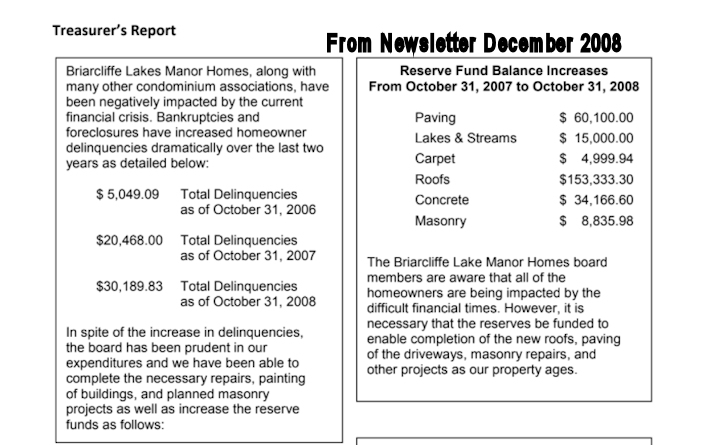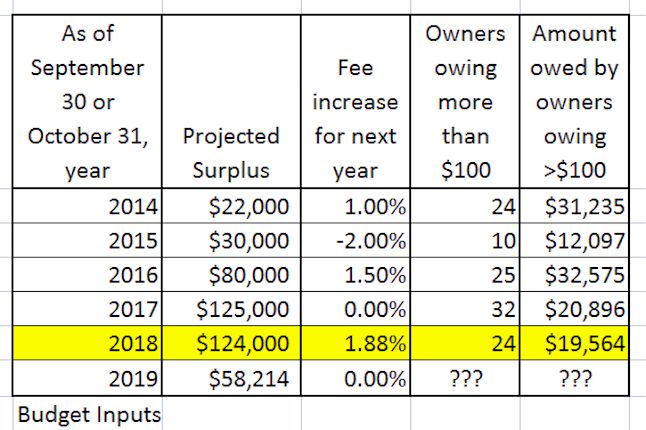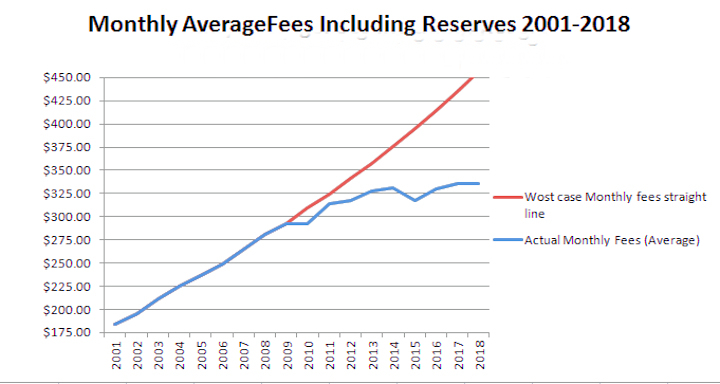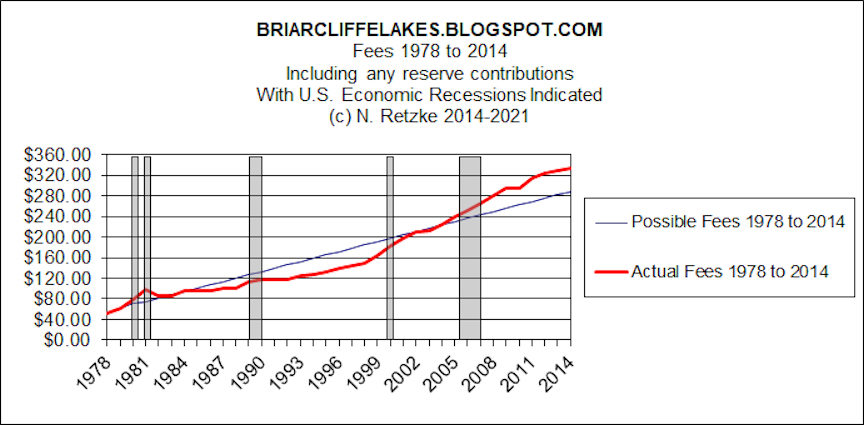I've just about completed the work to remove the fireplace. Here's a photo of the main living area. The fireplace was on the right. Removing it was a good choice, with a significant real estate tax reduction. I wanted an electric fireplace, but when I discovered this appliance would be listed as a "replacement" with the attendant tax increases, I decided to remove the original gas fired manufactured fireplace. Some day I might install a wall mount unit, but I can not see paying real estate taxes for an electric appliance!

Above: Intermittently, for a time, boards informed owners of association finances
Newsletter 2008 excerpt is an example of earlier board willingness to communicate with owners.
The boards of 2019-2021 prefer not to do so.
https://tinyurl.com/BLMH2021
Life and observations in a HOA in the Briarcliffe Subdivision of Wheaton Illinois
Best if viewed on a PC
"Briarcliffe Lakes Manor Homes" and "Briarcliffe Lakes Homeowners Association"
Updated Surplus Numbers

Updated Surplus Numbers: Actual surplus 2018 per audit was $85,163.
Boards 2011-2018 implemented policies and procedures with specific goals:
stabilize owner fees, achieve maintenance objectives and achieve annual budget surpluses.
Any surplus was retained by the association.
The board elected in fall 2018 decided to increase owner fees, even in view of a large potential surplus
Average fees prior to 2019

Average fees per owner prior to 2019:
RED indicates the consequences had boards continued the fee policies prior to 2010,
BLUE indicates actual fees. These moderated when better policies and financial controls were put in place by boards
Better budgeting could have resulted in lower fees

Better budgeting could have resulted in lower fees:
RED line = actual fees enacted by boards,
BLUE line = alternate, fees, ultimately lower with same association income lower had
boards used better financial controls and focused on long term fee stability
Friday, June 24, 2016
After removal of the fireplace
I've just about completed the work to remove the fireplace. Here's a photo of the main living area. The fireplace was on the right. Removing it was a good choice, with a significant real estate tax reduction. I wanted an electric fireplace, but when I discovered this appliance would be listed as a "replacement" with the attendant tax increases, I decided to remove the original gas fired manufactured fireplace. Some day I might install a wall mount unit, but I can not see paying real estate taxes for an electric appliance!
Labels:
Fireplaces
Stream #1 is up and running
A lot of of work had to be done to replace four decks with major issues. These had been built nearly 40 years ago with wooden pilings sunk into a stream. Of course, the pilings which I'm sure were not treated timber eventually rotted. The decks were removed, and treatment beneath was made to minimize water incursion. The new decks are supported on new concrete piers.
After the new decks were built we did grading of the stream bed, added a new pond lining material and crushed stone was placed on that. Water is expensive, and we don't want to waste it.
A couple of days ago an owner complained about the work. "It's taking too long." Yep, 12 rain days which means 24 if we let the saturated soil drain. Streams aren't to be up until late May. My opinion? Condominium living isn't for everyone. Neither is home ownership. Some might be best in an apartment.
Tuesday, June 21, 2016
Fireplace Saga
Back in the late 1970s when this area of DuPage County became a real estate "boom town" a lot of residential construction occurred.
Some of it was shabby and even local communities made mistakes. Did you know that Naperville didn't meet the Federal standards for evacuation streets? Probably not.
Here in Wheaton, the city made some terrible mistakes. These included the retention ponds including #1 through #4, which it seems were inadequate. It also approved and inspected the installation of at least 500 defective manufactured fireplaces. They were defective because of improper installation, but the code inspectors didn't catch even one flawed installation!
It took two serious fires to bring light to the fireplace issue, and the city condemned the few ostensibly defective fireplaces it could find. "Better late than never."
I've spent a few $thousand having the fireplace in my condo removed to meet city requirements. That included an architectural drawing mandated by the city. Go figure.
The final step is tearing up portions of a $5,000 floor to repair it so it looks like new. Here is a photo of step one; removal of sections which ended at the now removed fireplace. It is a "floating" floor comprised of interlocking bamboo sections and on top of an underlayment which meets HOA guidelines and was approved by management in writing for installation about 5 years go. This type of floor makes this relatively easy. Only $500 in materials to do this simple job. But we had to find a distributor in Georgia who carries this particular floor, as it is no longer manufactured. I'm one of about 330 people in this HOA who have had had to go through this process.
Labels:
Fireplaces
Thursday, June 16, 2016
962,668 Words
In recent months I've slowed the pace of posts for this blog. There are a number of reasons for this.
- With 962,668 words published, there is a lot of content on most of the relevant subjects which is already published here. It's very easy to scroll down the list of topics on the right to get to just about every post.
- In recent years the HOA has improved the newsletters and many are on the web. So there is no point in duplicating content.
- All meetings of the HOA are open to all owners, and that includes the October budget meeting. Budget meetings are now regularly scheduled and discussed during the HOA annual meeting as well as during normal HOA meetings.
- As a current member of the HOA board, I am restrained from what I can publish without getting prior board approval. This has had a profound impact on depth and breadth of this blog.
- I do have an additional 141 posts which have not been published. Some are placeholder posts which I expand from time to time and which will eventually be published. Others are partially complete. Quite a few were not published because they became irrelevant or I considered them to be too "sensitive" for some readers.
Comment:
Just typing at 80 WPM would require over 200 hours to type the content of the published posts. I've also got hundreds of photos, charts and spreadsheet content. Add the research and so on, Writing articles for the HOA newsletter has been a trivial task compared to doing this blog! The difficulty with the newsletter has been getting board members "on board" and to provide articles.
Labels:
668 Words,
962,
Hands are Tied
Monday, June 13, 2016
Bats, Not Easy to Love, Dying Daily by Thousands
This is a continuation of an earlier post about bats. The title is from an article published in 2013. The article states "......these are hard days for these peculiar animals, because they face mass extinction from a disease called White Nose Syndrome and every night thousands of are killed by energy-producing wind turbines that conservationists, economists and politicians hope will reduce this nation's need for foreign oil. Every solution to this perplexing energy problem comes with a downside, and wind turbines are no exception. A new study from the University of Colorado, Denver, estimates that 600,000 bats were killed by wind turbines last year alone."
The problem is similar to that faced by honey bees. Bees are also under stress and there is evidence that some bee extinctions are also related to human activities.
Why should anyone care about bat fatalities? "According to Bat Conservation International of Austin, Texas, the "low end estimate" of the value of bats to U.S. agriculture is at least $3.7 billion. Cotton farmers alone are saved about $74 per acre."
Let's not also ignore the millions of mosquitoes that are taken out of the air by bats.
There are several twists to this problem with wind turbines. For one thing, collisions aren't the problem. Spinning wind turbine blades create pressure changes in their vicinity. According to Erin Baerwald of the University of Calgary. This "sudden but subtle drop in atmospheric pressure from the blades causes internal hemorrhaging, a condition known as barotrauma. Bats are more vulnerable to barotrauma than birds, according to Baerwald, and bat fatalities far outnumber bird fatalities at most sites, so this has become "a bat issue, not a bird issue.""
The other interesting thing about the wind turbine problem is there is an easy solution. See the article for the explanation.
Finally, our government has take up the mantle of saving birds, but generally ignores the problems and stresses on bats. Perhaps a lack of education or too many horror movies which portray bats as vampires. Besides, there aren't any "save the bats" groups in every neighborhood, while birds get their own magazines, societies and so on.
Here's a link to the original article:
http://abcnews.go.com - wind turbine massacres of bats
Labels:
Bat Massacre,
Bats,
Wildlife
Saturday, June 11, 2016
Driving us Batty
Bats are one of the critters which inhabit the area and we frequently see them flying in the park across the street at dusk.
Each bat kills thousands of insects each night. Many of those are mosquitoes. Other natural mosquito predators include dragonflies. According to an article in the Patch: "Bats play an important role in the local ecosystem and can significantly reduce the insect population in your neighborhood. “One bat can eat up to 3,000 mosquitoes in one night, or any insect outside after dark, like moths and crickets,” said Christopher Appelt, a biologist and associate professor at Saint Xavier University in Chicago. “Put 100 bats out there, and they can eat 300,000 insects in one night.”"
On occasion it is my understanding residents of our community have found one roosting in the space between deck supports. Generally, these are invisible to us and we aren't even aware they are in the air space or on the property. One sign is bat dung. I've attended HOA meetings where an owner complained about a bat. They can be relocated or as the professionals prefer to say "excluded." The article states that "Bats in the United States are protected species.....It is against the law...to kill or poison bats when removing them from buildings. Bat exclusion is also prohibited when pups are still nursing and in the roost."
The article provides some interesting statistics about rabies and also preventative tips.
The article uses some interesting language, including the article title. The Patch apparently feels the need for sensationalism to get us to read their articles, and stick around long enough to click on those ads.
While bats are generally beneficial and invisible, the article quoted a "Senior Bat Technician" as saying: “The Midwest is just unbelievably infested with bats.....I’d say 80 percent of neighborhoods are infested with bats, and people don’t even know about it.”
My opinion is it would be more realistic to state that the area is unbelievably infested with mosquitoes. But a Senior Bat Technician has got to eat.
The Chicago Patch posted one of the better articles I've seen and I've included a link here.
http://patch.com/illinois - article on bats June 10, 2016
Thursday, June 9, 2016
Clueless
In any given month, our HOA monthly meeting is attended by two or three owners. In an HOA with 336 minus the 6 currently on the board, this poses a real problem.
In a nutshell, our owners are clueless. Becaused they don't attend monthly meetings they aren't aware of the board discussions and the issues. They aren't aware that the longest term board member who advocates "financial" responsibility and who began a $2 million + project with no means to complete it in less than 20 years has argued during budget meetings for two years for substantially higher fees. Or substantially more onerous rules. That's after a decade of a cash strapped HOA.
There are a lot of quaint expressions that I have heard. "Clueless", "Stupid is as stupid does", and so on. Some times these do sum up a situation, Frequently they are misused. "Slamming the barn door shut after the horses have left" is another expression. It seems to fit current circumstances. Yet another expression is "You can't teach old dogs new tricks." But I do keep trying. Some learn and some don't. Some will and some won't. [I've been training people in business and as a volunteer for nearly four decades; some of these groups achieved extraordinary things.]
A lot has been accomplished since 2008. Some subtle pressure was required, and some not so subtle pressure including a palace revolt. There is only so much I can do. Owners are oblivious to the doings in executive session. That's a great way for politicians to torpedo other board members if they are so inclined and owners are completely unawares. In a HOA if the owners are unawares they may continue to elect the politicians and any "feel good" group. Not that we all have a feel good plan. Here at BLMH one plan enacted for a long long time was to delay repairs as long as possible so funds funds could be accumulated for that behemoth roofing project. Owners noticed, too and that's why some owners came to HOA meetings a decade ago and complained "What do we get for our money?" This type of strategy puts owners in a position where they must come to a HOA meeting and argue to get their improvement. "The squeaky wheel gets the grease." and those inclined to be power brokers love it. After all, what good is power if one can't exercise it? Me, I've got better things to do with my time and talents. As I've stated repeatedly I don't have to live here. I've set up home bases in MI and and AZ. I can rent or sell my BLMH unit at any time. I'm not a member of that less than 5% group who promotes themselves and the "Neighbors Club." In other words, this HOA needs worker bees far more than we, the owners, need them.
In my brief tenure on the board I have upgraded the newsletter from a "feel good" sales brochure or fluff piece to something that informs owners of some of the issues facing the HOA. I refer to our owners as "shareholders" which is precisely what they are, but that is like pouring gasoline on a fire. For many reasons, as well as my willingness to go against the grain and get things done, it is my understanding that one board member has told management that I'm unfit to be on the board. Some people play games, throw others under the bus and treat everyone with disdain. It is not unusual for the entrenched to do whatever they feel is necessary to protect their legacy. But board members are supposed to be fiduciaries! As I've stated repeatedly, owners do get the boards they deserve. Previous boards, cash strapped because of their lack of planning deferred maintenance and put all of the "reserve" money into an ill planned and underfinanced roofing project.It took another board to raise the money to do the work they began, I spent 5 years putting together a program to not only get that project done, but also all of the other maintenance items ignored or deferred.
In fact it took a new board to get a reserve study and to raise fees to the level required to fund these projects. One board member who presided over this multi million project made the point of accosting me during a HOA meeting and stated "You spend all of the money," It can be difficult for us to take responsibility for our actions and it is better to blame others for our lack of accomplishment. I will stand on my record, as imperfect as it is. Boards are required to treat all owners equally. In taking up the mantle of responsibility I was required as a fiduciary to finish this project for the remaining 280 owners. After all, we are all equals, aren't we? We are each to be treated fairly and consistently and uniformly, board members included.
Using the approach advocated by the most experienced board members, the president got a new roof first, and the rest of the owners after an interval got new roofs in the increment of 2 to 3 roofs per year. Simple arithmetic indicated the rest of us would get new roofs in 14 to 21 years, at which time some roofs would be 30+ old. The fly in the ointment was the fact that these roofs were designed for 18-20 years maximum. However, the "fiduciary" boards were apparently more interested in taking care of number one. Recently, the concern was raised by a resident of the first building to be re-roofed that this roof might be "defective." This roof was installed without the attic insulation added in following roofs. Attempts by a resident to get insulation added were rebuffed by me. I stated that "There are a lot of people here who have old roofs and are waiting in line. After the completion of the project, we'll revisit that first roof." That was insufficient and "where there is a will there is a way." No matter that many other owners had 15-20 year old failing roofs. There is a simple decision if one does not have attic insulation and some owners have dealt with this so called "deficiency" by installing attic insulation at their own expense.
The problem facing our HOA is simple. Very little owner involvement, board issues and inadequacies, personal agendas at play. and board members who have no where else to go. Here is one valid concern. Our HOA board is comprised of individuals who are entirely above the age of 65. Mental degeneration begins at the age of 50. We begin to lose cognitive ability at the age of 50. Certain illnesses accelerate that. So would you entrust your major financial investment to a bunch of amateurs above the age of 65? I guess our HOA owners feel that's perfectly appropriate.
Stupid is as stupid does. My point? It's your money and you can flush it as you see fit, or entrust it to those you choose! That's exactly what owners do when they post their annual votes, or decide not to vote. In our HOA we have great difficultly getting half of the owners to cast their annual votes. Of course, some of the pap pieces provided by some candidates on their forms doesn't help; after all, the politicians would never get elected if they stated " I think owners are stupid and I want much higher fees." But that is the reality. To the owners all I can say is "Don't come to a HOA meeting and complain "How could this happen.""
One thing I've learned at BLMH is this. One would think that those of us who are trapped, who can't leave or lack the financial wherewithal because we have no where else to go would be the most capable, and the most interested in HOA success. That is absolutely not true. Those of us who have no where to go are most interested in maintaining power, running our agenda and maintaining the status quo. After all, if we left, what could we do? Watch "Wheel of Fortune" I guess.
Subscribe to:
Posts (Atom)


